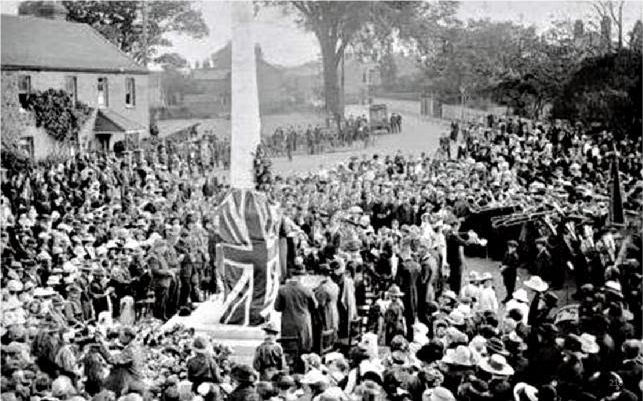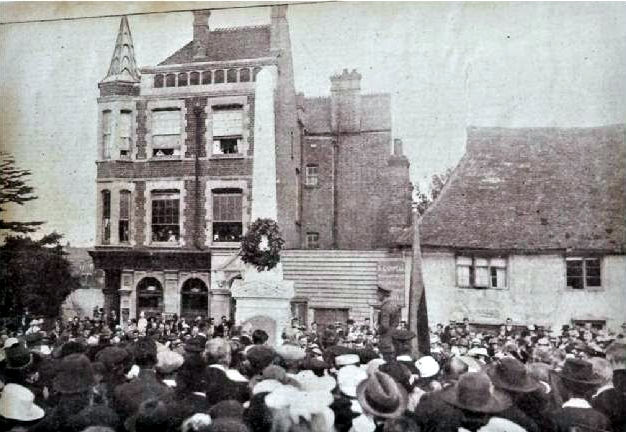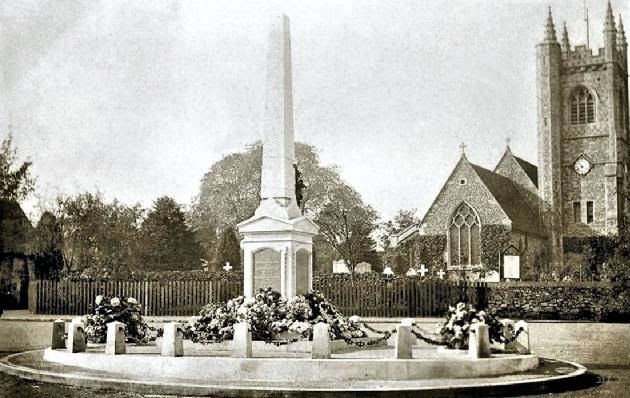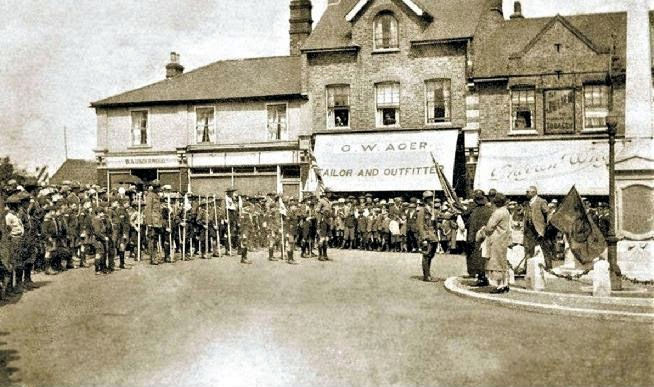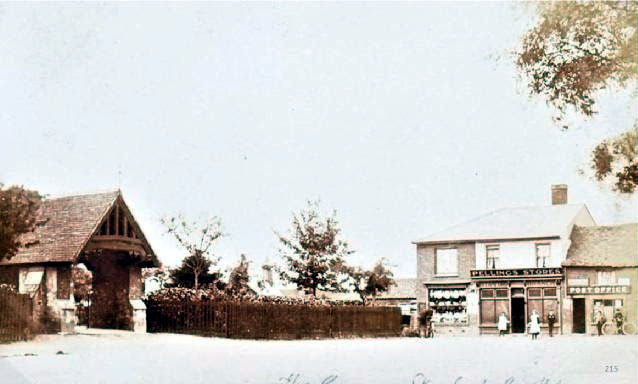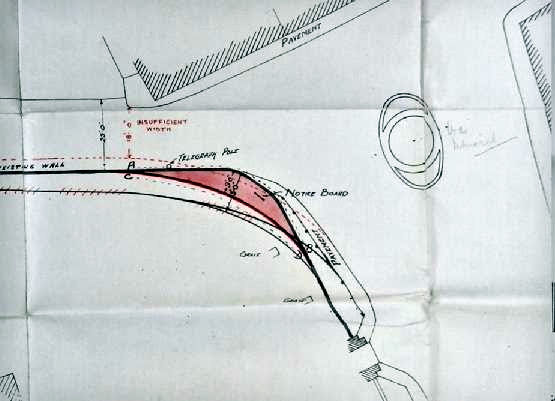The War Memorial
The Armistice that ended the fighting in the First World War was signed on a date that has become one of the most significant in history, the Eleventh Day of the Eleventh Month, 1918. The Eleventh Hour at which time there is nationwide observance of a two minutes silence in memory of the fallen, referred to the time of the signing of the Treaty of Versailles on 28th June 1919 which marked the official end of hostilities.
The terrible conflict, “The War to End All Wars” that had lasted for four years, cost the lives of a total of over thirty seven million people as a direct result of the fighting and disease and starvation. Some six million of these were missing presumed dead. The United Kingdom lost almost 900,000 military personnel with over 1.6 million wounded, many with grievous injuries. There were some 2000 direct civilian deaths and over 100,000 excess deaths mainly as a result of disease and deprivation caused by the war. In all, the country lost nearly one million people, many of them the flower of the youth. Stanford-le-Hope lost eighty-three military personnel in the conflict. As with most of those who fought in the war, many had been civilian volunteers who had answered the call to service.
In the wake of the conflict there was an overwhelming desire throughout the country that those who had sacrificed their lives should be remembered in perpetuity by the erection of memorials in virtually every town and village. The residents of Stanford-le-Hope were no exception and were the first in the Orsett Union area to propose a memorial and raise the funds for its construction.
Initially there was some controversy regarding the nature of the memorial to be built. A poll taken amongst the villagers had resulted in a small majority in favour of a stone monument over a proposal for a cottage hospital. Other proposals were for almshouses, a recreation ground, parish hall, and a village nurse. It was felt by many that if money was to be raised for a fitting memorial to the fallen of the war then it should be spent on something useful rather than a monument.
There was much discussion by the Parish council on this subject and a War Memorial Committee was formed under the chairmanship of Walter Levett to move the project forward. The committee decided to erect a stone obelisk on The Green with the existing parish lamp being relocated. Most of the funding for the memorial was raised by the villagers with generous donations from local companies such as London and Thames Haven Oil Wharves and private individuals such as Alfred Courthope Adams who was resident at Grove House.
Further discussions took place at public meetings as to whether the names of those who had lost their lives in the conflict should be added to the memorial with a suitable inscription on one of the faces as this involved additional cost. It was finally agreed at a public meeting held in April 1920 that this should be done and the villagers were again asked to meet the cost. It was further decided to let the contract for the memorial itself and for the foundations and surrounding garden with the date of 26th September 1920 being fixed for the unveiling and dedication.
In all the sum of £741 was eventually raised which was sufficient to erect and dedicate the memorial. In hindsight there is little doubt that in spite of opposition to a monument by some individuals, the decision to opt for one was correct. The monument has been at the centre of the village since its dedication and is always the site of impressive gatherings on Remembrance Sunday. It is probable that a cottage hospital or almshouses would not have survived in the long term and the names of the fallen and the inscription would have had to have been relocated.
The memorial was dedicated on Sunday 26th September 1920 as planned. The Grays and Tilbury Gazette dated October 2nd 1920 described the proceedings:- “It was a memorable occasion at Stanford-le-Hope on Sunday afternoon, when the village war memorial was unveiled and dedicated in the presence of a large concourse of people. Close on three thousand people congregated around the memorial on The Green and participated in the solemn ceremony which was held, the unveiling being performed by Mrs. A. C. Adams.
The memorial consists of a handsome obelisk in Portland stone with panels of Peterhead granite. Standing on three steps, it is erected within an oval enclosure, marked off by low stone pillars and chains, the surrounding space being filled in with Derbyshire spar. Two fine hydrangea plants in tubs add brightness to the arrangement, these to be replaced in the winter by evergreens. On Sunday the obelisk was also adorned with a laurel wreath while the base was a mass of flowers and wreaths brought by the villagers. The principal panel on the monument bears the inscription ‘This monument was erected by the inhabitants of Stanford-le-Hope in grateful memory of the men of this parish who sacrificed their lives in the cause of liberty in the Great War 1914 – 1919’. On the side panels appear the names of some 70 of the fallen.
The unveiling was accompanied by a service in which the rector, the Rev. J. Russell, the Rev. W. Britten Butters, Wesleyan Minister, and Captain Parker, Salvation Army, took part. Among those also present were Colonel F. Hilder M.P.; Mr.W. Levett (chairman of the Parish Council); Mr.A.W. Kerly J.P., C.A. and Mrs. Kerly, and members of the committee and Parish Council.
The arrangements were in the hands of the secretary Mr. A. A. Gwynne-Phillips. Prior to the ceremony the Stanford-le-Hope band played the discharged service men from the Ivy Leaf Club to The Green, while the Salvation Army band also participated in rendering the hymns. The various Sunday School children were given positions around the monument, while the Stanford-le-Hope Boy Scouts were on duty under Scoutmasters Phillips and Cox.
The service opened with the hymn “Stand Up, Stand Up for Jesus” followed by prayers read by the Rector, Mrs. Adams having removed the flags covering the panels on the obelisk, it was profusely dedicated by the Rector.
The article then gives an account of the speech made by Lt.Col. Hilder and concludes with:-
“Prayers by the Rev. W. Britten Butters and Captain Parker” followed, and after the hymn “For All the Saints” the Last Post was sounded by Mr. Finch and the service concluded with the Blessing by the Rector. The bells of the parish church finally rang out in a half muffled peal, the flag on the tower being at half mast.
A large number of floral offerings were later arranged round the base of the memorial”.
The memorial actually lists eighty three names from the First World War. Twenty names of those who fell in the Second World War were subsequently added. These latter names were engraved on tablets that rest against the top step.
This was not quite the end of the construction associated with the War Memorial. After it was erected it became apparent that there was insufficient clearance between the memorial and the church fence adjacent to it for the increasing road traffic.
In June 1922 the Orsett Union petitioned the Bishop of Chelmsford to allow the widening of Church Hill by realigning the existing wall of the churchyard. The petition read as follows after the salutation:
“That a War Memorial has been erected in the highway opposite the north east corner of the churchyard of the parish church of Stanford le Hope in the County of Essex and the Diocese of Chelmsford and in consequence thereof the said north east corner of the said churchyard now forms a sharp contour to the roadway making it inconvenient for vehicular traffic thereon.
That your petitioners are desirous of widening the said highway by throwing a portion of the said churchyard into the street as shown on the plan annexed hereto and thereon coloured prints, the existing wall of the churchyard being indicated by the black line A to B and the proposed new wall by the red line C to D. That at a meeting of the Parochial Church Council held on the second day of March 1922 pursuant to public notice being given according to law the following resolution was agreed to:-
On examining the petition and plan for the widening of the roadway at the north east corner of St.Margaret’s churchyard, Stanford-le-Hope this meeting of the Parochial Church Council of Stanford-le-Hope unanimously approves the proposal to obtain a faculty in accordance with the conditions and terms stated in the petition of the Rural District Council of Orsett.”
The petition went on to state that in consideration of the loss to the church of that piece of the ground that a sum of £70 was to be paid to the church funds and that an assurance was given that no remains were interred in the land to be given over. The petition was signed by the Parish Council and commended to the Bishop by the Rector of Stanford James Russell.
The works did indeed go ahead and result in the road layout on
The Green and Church Hill that we are familiar with today.
